Paul P Mark
Rookie
- Apr 18, 2018
- 42
- 111
- AFL Club
- Brisbane Lions
A fond memory as a young boy when staying over at my Nanna and Pop’s house in the mid-80s was looking through the annual Miller’s Guide sporting publications that my Pop had accumulated over the years. Although horse racing focused, these guides, in their thick paperback book format, were a treasure-trove of sporting records from around the world.

I loved looking down the list of VFL (as it was still known in the ‘80s) premiers and runners-up since 1897. Yes, the first VFL season was way back in 1897. The trusty Miller’s Guide revealed that Essendon won that first one. I would continue down the list…
“Collingwood won four flags in a row from 1927 to 1930!” I remember exclaiming to Pop one time as he was studying the form guide for the next day’s races at Flemington. “Jock McHale was coach” he replied, “No other club has ever done it”.
As of 2018 - that record still stands. Four premierships in a row from 1927-1930. What’s more, Collingwood had finished runners-up in the grand finals of 1925 and 1926 – which means the streak also included six consecutive grand final appearances. So, Jock McHale’s men lost two, and then won the next four. Legendary stuff. But is it enough to claim the title of the best era in VFL/AFL history? Let’s find out.
What length of time constitutes an era?
The minimum - 5 years
One of the most difficult aspects of this ranking process was deciding the length of time that constitutes a true dynasty/reign of dominance/era. As I began the research involved in getting a clearer picture, one thing soon became apparent - the length of any truly successfully sustained era couldn’t be less than five years in duration. As you’ll see in the table below, two clubs boast eras that achieved seven consecutive grand final appearances. Two others made the grand final six times in a row. Yet another two clubs have made the grand final five times in succession. That means we have six separate occurrences of a club reaching the grand final at least five times in a row. So, five years had to be the minimum length of an era.
The maximum – 8 years
At the other end of the scale we also need to have a cut-off point. Some may even argue an ‘era’ can perhaps only be regarded as a true era whilst under the guidance of the one coach, the one guru. Well, of the 12 eras I ranked, only three clubs had more than one coach at the helm during the period, which is quite fitting really. But the main deciding factor was changes to playing personnel. If you go longer than eight years, the ‘core’ group of players tends to change too dramatically to constitute a recognizable ‘era’.
How to rank them?
Total premierships won in the period simply had to be the number one ranking method. Coaches, players and supporters want to win premierships - that is the goal year in, year out. So, the eras are ranked by total premierships first, then by consecutive grand final appearances, then by consecutive premierships where applicable.
So here we have it in the table:
Click to enlarge

As you can see, there are some amazingly successful eras in this list. What’s more, it was only after I had settled on this top 12 that I realised every single decade of the game’s 120 year history is included! What a testament to this great competition. Below is a summary of the top 3.
#1: Melbourne of 1954-1960 coached by Norm Smith

Ron Barassi holds up the 1964 premiership cup alongside Ray Gabelich
This was a run of seven consecutive grand finals, netting five premierships, which also featured a triple and a double. Astonishing. Thus, this Norm Smith-coached Melbourne of 1954-1960 takes the number one position as the best era in VFL/AFL history. Besides being the only side to win five premierships in an era, if you have a look at the stats when playing at either home or away, we see that Norm Smith’s boys, captained by the legendary Ron Barassi, had a remarkable home win rate of 91% with a points percentage of 157.8%. In fact, they only lost six games at home in seven seasons! The MCG was their fortress, their coliseum. They owned it. And, mind you, this was done in an era without playing against travelling non-Victorian sides – they never even had a home-state advantage yet still won 91% of home games. Remarkable.
Melbourne is also one of only two clubs, along with Hawthorn, to make this list twice. When you consider Norm Smith was captain during the other great Demons era of 1937-1941, which also featured a ‘three-peat’, it really is no wonder that the award for the best player in the grand final is titled the Norm Smith medal.
#2: Collingwood of 1927-1930 coached by Jock McHale

The legendary Jock McHale (above) and Collingwood team photo 1930

I’m guessing many people, especially Collingwood supporters of course, might argue that being the only side to have managed to win four premierships in a row, is deserved of the number one ranking position. Well, while four in a row is definitely the best streak in VFL/AFL history, I felt Melbourne’s effort of winning five premierships in seven years, including a triple and then a double, was superior. But don’t get me wrong, this Collingwood effort was more than just a streak of course. It was kind of an era within an era given it was the pinnacle period of Jock McHale’s staggering 38-year coaching stint at Victoria Park.
As can be seen in the table, this golden run featured six consecutive grand final appearances, having been beaten in the grand finals of 1925 and 1926 before going on to score the ‘quadrella’.
The Magpies’ overall win percentage of 81% from their 122 games is also the second best in the entire list. (second only to Geelong of 2007-2011)
Even though these ratings are purely based on statistics, this effort by Collingwood was also a great example of perseverance – many a group of men in woeful economic times may have never gotten over the anguish of losing consecutive grand finals in 1925 and 1926. Quite to the contrary however, they went on to win the next four in a row!
Whether you barracked for Collingwood or not, this was an extraordinary feat that brought inspiration and hope to a down-trodden city during the Great Depression.
#3: Hawthorn of 1983-1989 coached by Allan Jeans

Hawthorn captain Michael Tuck and coach Allan Jeans hold up the 1989 premiership cup
Oh, they were indeed a happy team at Hawthorn in the ‘80s! Although I have them at number three, the mighty Hawthorn lineups of 1983-1989 may well be the most universally regarded ‘best ever’ in history. You just hear so much about them. And it’s not difficult to see why. Four premierships in seven years, and one of only two eras that featured seven consecutive grand finals. They possessed players of all-time greatness from one end of the field to the other. Could they have been number one? Well, losing to Essendon twice in a row in 1984 and 1985 conjures up questions of what might have been. The Dons sure did extract revenge, and then some, on the Hawks after going down to them in 1983. Still, the Hawks bounced back in 1986 to beat Carlton, who in turn however, extracted some revenge of their own on the Hawks in 1987.
So after finishing runners-up three times already by 1987, it may have appeared the Hawks’ quest for going back-to-back was shot. Not this outfit though - they then went on to win the flags of 1988 and 1989 against Melbourne and Geelong respectively. The grand final of 1989, in which the Hawks prevailed by 6 points, is still regarded as one of the most bitterly fought and highest quality grand finals ever contested.
After finishing fifth in 1990, Hawthorn won yet another flag in 1991. This was the only instance where I was tempted to make an exception to the eight-year era limit. Extending their era to 1991 would have made it five premierships from nine years. Still not superior to Melbourne’s five from seven though. Adding to my decision was the fact that, after 1990, Allan Jeans had permanently handed over the reins of head coach to Alan Joyce (who had stood-in as caretaker coach during Jeans’ illness in 1988), which further signified the end of an era.
HONOuRABLE mentions
There are many more truly epic eras in the list which deserve mentioning, but I shall stick to the ones I have personally witnessed live.
The Brisbane Lions were almost unbeatable when it mattered most

Leigh Matthews and Michael Voss hold aloft the 2003 Premiership cup.
I certainly wish to mention the mighty Brisbane Lions sides of 1999-2004 coached by Leigh Matthews. Although they came in at #8, I would dare suggest that, at their very best, they were in fact the very best the league has seen. Along with their renowned hardness and fearlessness, this was an outfit that included three Brownlow medalists in their midfield (Michael Voss, Jason Akermanis, Simon Black) plus Nigel Lappin who could have easily won one himself. Jonathan Brown, Alistair Lynch, Justin Leppitsch, the Scott twins, the list of greats goes on.
Now, a lot of pundits rate Kevin Sheedy's Essendon side of 2000 as the best ever playing group. Sure they only lost one game in that premiership year, but what many seem to forget is that virtually the same Essendon lineup was soundly beaten by Brisbane the following year in 2001. Essendon were unable to go back-to-back, but these Lions were just getting started in winning three in a row from 2001-2003. Unfortunately for Brisbane however, their shot at unarguable immortality was thwarted by a brilliant Port Adelaide in the 2004 grand final.
Geelong have the stats, but the Hawks have the results

Luke Hodge and Alastair Clarkson after winning the 2013 Premiership
There are two other teams I wish to mention. These happen to be the two most recent, and overlapping, eras on the list - the arch rivals of modern times - Alastair Clarkson's Hawthorn of 2008-2015 and Geelong of 2007-2011 coached by Mark Thompson and Chris Scott.
Let's start with Geelong. If you look at the stats table, they top, or equal top, every single match stat - winning percentage of games for overall, home, and away - same goes with the all-important points percentage (points for/ points against).
Here is the table again. Behold Geelong's row of highlighted stats.
Click to enlarge

This stat-topping Geelong unit had a plethora of greats including Gary Ablett Jr, Joel Selwood, Jimmy Bartel, Steve Johnson plus many more. There is no doubt they regularly fielded some of the best line-ups in AFL history.
Mystery still surrounds the circumstances leading up to coach Mark Thompson's resignation at the completion of the 2010 season after finishing 3rd. Had his heart been in it that year? Would they have won it otherwise? Who knows, but Chris Scott was certainly lucky to inherit such an accomplished playing group whom he took to a premiership during his first year as coach in 2011. But alas, after 2011, there were no more grand final berths.
Although no other club matches Geelong's overall statistical dominance across five seasons, they are ranked 11th because this ranking system is weighted towards total premierships first and foremost. Geelong 'only' won three premierships and also didn't manage to go back-to-back. In fact, they are the only team to win three or more premierships in an era without winning any in succession.
Unfortunately for them, it all comes down to the 2008 grand final loss to Hawthorn. Mention this grand final to any avid Geelong supporter and the pain will be evident on their face. If they had won this grand final, their era would've yielded four premierships instead of three, and would've also most likely included a 'three-peat' instead of no consecutive premierships at all. Ouch. So did they blow it? I actually don't think so.
The Hawks had a freakishly talented side in 2008

Luke Hodge and Stuart Dew celebrate with the 2008 Premiership cup.
After smashing Port Adelaide by a record margin in the 2007 grand final, Geelong were expected to go back-to-back in 2008. In the grand final, the bookies had installed them firm favourites against the younger Hawks who seemed to have come from nowhere in recent years to suddenly find themselves in the big dance. How could these young upstarts possibly bother the all-conquering Cats? One 'word': X-Factor.
X-factor is very hard to define. I'd say it has has something to do with performing almost-impossible feats when it matters most. This Hawks 2008 lineup had it in spades. They were younger, but not too much younger and still had plenty of seniority around with the likes of their spiritual leader and Brownlow medalist Shane Crawford, and the powerfully versatile key position player Trent Croad. Sadly, but maybe fittingly, for both of these club stalwarts the 2008 grand final would be their last game.
At the other end of the spectrum, the Hawks had the amazingly talented Cyril Rioli who was playing his first season and, speaking of X-factor, they had a mercurial medium-sized forward, with a penchant for imaginary shotguns, by the name of Mark Williams. He kicked a game-high three goals without even firing an imaginary shot! (His shotgun celebration had been banned earlier in the season by Alastair Clarkson).
Then you had Stuart Dew. An experienced recruit whose awe-inspiring third quarter purple patch was one for the ages. X-factor again.
When you also take into account that Coleman medalist Lance "Buddy" Franklin, Jarryd Roughhead, Luke Hodge, Sam Mitchell, Jordan Lewis, Grant Birchall, Campbell Brown, and Brad Sewell had just entered their prime, the level of talent starts to look frightening.
I feel that in the 2008 grand final, Geelong didn't blow it, they were simply beaten by a better side. A side whose same core group of players, although faltering to miss the finals in 2009, would ultimately go on to reach four more grand finals and win three more premierships - all in succession. That's why Alastair Clarkson's men are ranked so high (4th) on the all-time list of the great AFL eras.
So there you have it! I chose not to go into the details surrounding all 12 eras in the list, but I am satisfied with my ranking method. Any feedback is welcome - please leave a comment!
Cheers,
Paul P Mark
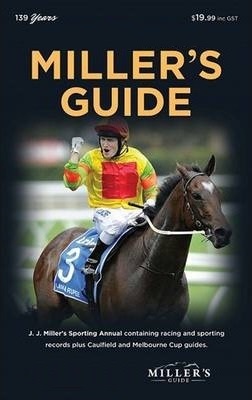
I loved looking down the list of VFL (as it was still known in the ‘80s) premiers and runners-up since 1897. Yes, the first VFL season was way back in 1897. The trusty Miller’s Guide revealed that Essendon won that first one. I would continue down the list…
“Collingwood won four flags in a row from 1927 to 1930!” I remember exclaiming to Pop one time as he was studying the form guide for the next day’s races at Flemington. “Jock McHale was coach” he replied, “No other club has ever done it”.
As of 2018 - that record still stands. Four premierships in a row from 1927-1930. What’s more, Collingwood had finished runners-up in the grand finals of 1925 and 1926 – which means the streak also included six consecutive grand final appearances. So, Jock McHale’s men lost two, and then won the next four. Legendary stuff. But is it enough to claim the title of the best era in VFL/AFL history? Let’s find out.
What length of time constitutes an era?
The minimum - 5 years
One of the most difficult aspects of this ranking process was deciding the length of time that constitutes a true dynasty/reign of dominance/era. As I began the research involved in getting a clearer picture, one thing soon became apparent - the length of any truly successfully sustained era couldn’t be less than five years in duration. As you’ll see in the table below, two clubs boast eras that achieved seven consecutive grand final appearances. Two others made the grand final six times in a row. Yet another two clubs have made the grand final five times in succession. That means we have six separate occurrences of a club reaching the grand final at least five times in a row. So, five years had to be the minimum length of an era.
The maximum – 8 years
At the other end of the scale we also need to have a cut-off point. Some may even argue an ‘era’ can perhaps only be regarded as a true era whilst under the guidance of the one coach, the one guru. Well, of the 12 eras I ranked, only three clubs had more than one coach at the helm during the period, which is quite fitting really. But the main deciding factor was changes to playing personnel. If you go longer than eight years, the ‘core’ group of players tends to change too dramatically to constitute a recognizable ‘era’.
How to rank them?
Total premierships won in the period simply had to be the number one ranking method. Coaches, players and supporters want to win premierships - that is the goal year in, year out. So, the eras are ranked by total premierships first, then by consecutive grand final appearances, then by consecutive premierships where applicable.
So here we have it in the table:
Click to enlarge

As you can see, there are some amazingly successful eras in this list. What’s more, it was only after I had settled on this top 12 that I realised every single decade of the game’s 120 year history is included! What a testament to this great competition. Below is a summary of the top 3.
#1: Melbourne of 1954-1960 coached by Norm Smith
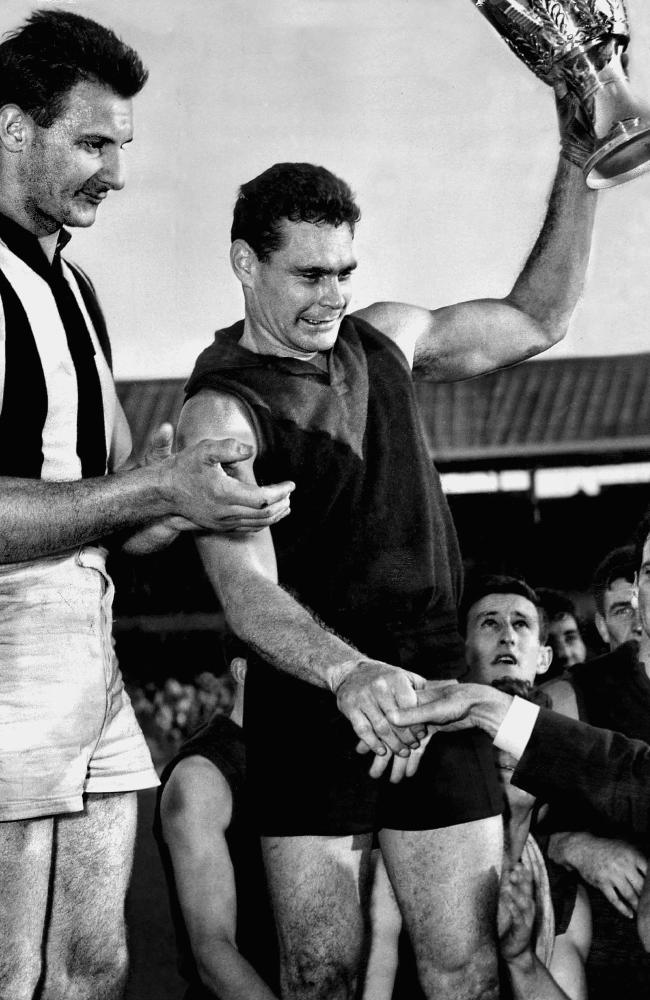
Ron Barassi holds up the 1964 premiership cup alongside Ray Gabelich
This was a run of seven consecutive grand finals, netting five premierships, which also featured a triple and a double. Astonishing. Thus, this Norm Smith-coached Melbourne of 1954-1960 takes the number one position as the best era in VFL/AFL history. Besides being the only side to win five premierships in an era, if you have a look at the stats when playing at either home or away, we see that Norm Smith’s boys, captained by the legendary Ron Barassi, had a remarkable home win rate of 91% with a points percentage of 157.8%. In fact, they only lost six games at home in seven seasons! The MCG was their fortress, their coliseum. They owned it. And, mind you, this was done in an era without playing against travelling non-Victorian sides – they never even had a home-state advantage yet still won 91% of home games. Remarkable.
Melbourne is also one of only two clubs, along with Hawthorn, to make this list twice. When you consider Norm Smith was captain during the other great Demons era of 1937-1941, which also featured a ‘three-peat’, it really is no wonder that the award for the best player in the grand final is titled the Norm Smith medal.
#2: Collingwood of 1927-1930 coached by Jock McHale
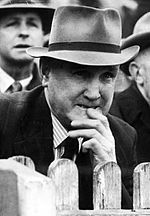
The legendary Jock McHale (above) and Collingwood team photo 1930
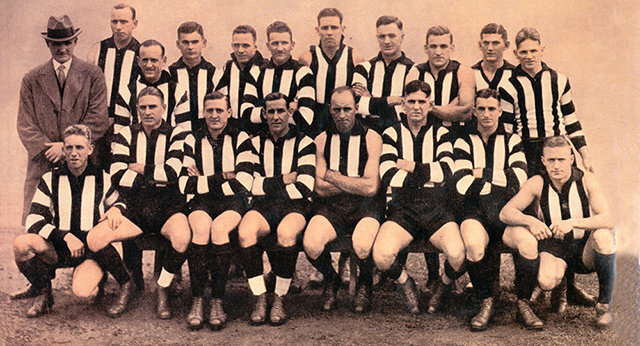
I’m guessing many people, especially Collingwood supporters of course, might argue that being the only side to have managed to win four premierships in a row, is deserved of the number one ranking position. Well, while four in a row is definitely the best streak in VFL/AFL history, I felt Melbourne’s effort of winning five premierships in seven years, including a triple and then a double, was superior. But don’t get me wrong, this Collingwood effort was more than just a streak of course. It was kind of an era within an era given it was the pinnacle period of Jock McHale’s staggering 38-year coaching stint at Victoria Park.
As can be seen in the table, this golden run featured six consecutive grand final appearances, having been beaten in the grand finals of 1925 and 1926 before going on to score the ‘quadrella’.
The Magpies’ overall win percentage of 81% from their 122 games is also the second best in the entire list. (second only to Geelong of 2007-2011)
Even though these ratings are purely based on statistics, this effort by Collingwood was also a great example of perseverance – many a group of men in woeful economic times may have never gotten over the anguish of losing consecutive grand finals in 1925 and 1926. Quite to the contrary however, they went on to win the next four in a row!
Whether you barracked for Collingwood or not, this was an extraordinary feat that brought inspiration and hope to a down-trodden city during the Great Depression.
#3: Hawthorn of 1983-1989 coached by Allan Jeans
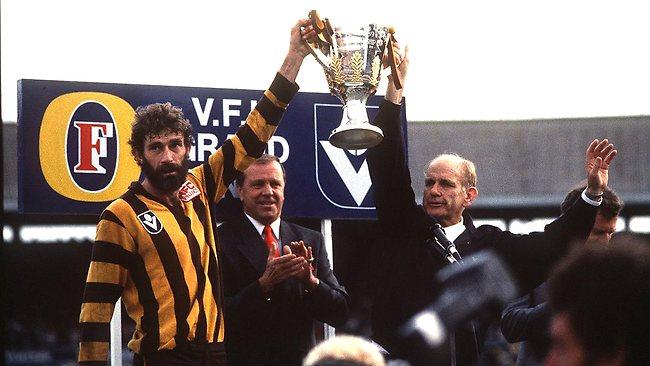
Hawthorn captain Michael Tuck and coach Allan Jeans hold up the 1989 premiership cup
Oh, they were indeed a happy team at Hawthorn in the ‘80s! Although I have them at number three, the mighty Hawthorn lineups of 1983-1989 may well be the most universally regarded ‘best ever’ in history. You just hear so much about them. And it’s not difficult to see why. Four premierships in seven years, and one of only two eras that featured seven consecutive grand finals. They possessed players of all-time greatness from one end of the field to the other. Could they have been number one? Well, losing to Essendon twice in a row in 1984 and 1985 conjures up questions of what might have been. The Dons sure did extract revenge, and then some, on the Hawks after going down to them in 1983. Still, the Hawks bounced back in 1986 to beat Carlton, who in turn however, extracted some revenge of their own on the Hawks in 1987.
So after finishing runners-up three times already by 1987, it may have appeared the Hawks’ quest for going back-to-back was shot. Not this outfit though - they then went on to win the flags of 1988 and 1989 against Melbourne and Geelong respectively. The grand final of 1989, in which the Hawks prevailed by 6 points, is still regarded as one of the most bitterly fought and highest quality grand finals ever contested.
After finishing fifth in 1990, Hawthorn won yet another flag in 1991. This was the only instance where I was tempted to make an exception to the eight-year era limit. Extending their era to 1991 would have made it five premierships from nine years. Still not superior to Melbourne’s five from seven though. Adding to my decision was the fact that, after 1990, Allan Jeans had permanently handed over the reins of head coach to Alan Joyce (who had stood-in as caretaker coach during Jeans’ illness in 1988), which further signified the end of an era.
HONOuRABLE mentions
There are many more truly epic eras in the list which deserve mentioning, but I shall stick to the ones I have personally witnessed live.
The Brisbane Lions were almost unbeatable when it mattered most
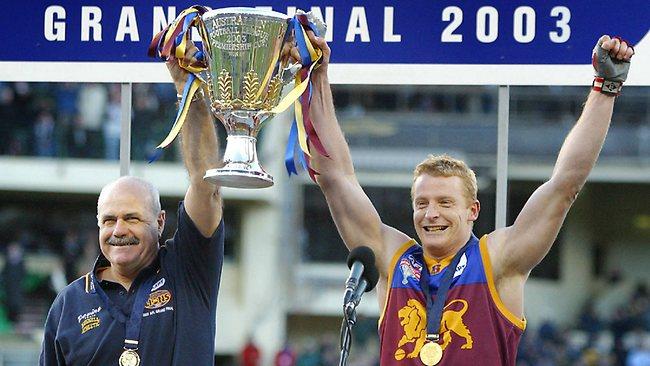
Leigh Matthews and Michael Voss hold aloft the 2003 Premiership cup.
I certainly wish to mention the mighty Brisbane Lions sides of 1999-2004 coached by Leigh Matthews. Although they came in at #8, I would dare suggest that, at their very best, they were in fact the very best the league has seen. Along with their renowned hardness and fearlessness, this was an outfit that included three Brownlow medalists in their midfield (Michael Voss, Jason Akermanis, Simon Black) plus Nigel Lappin who could have easily won one himself. Jonathan Brown, Alistair Lynch, Justin Leppitsch, the Scott twins, the list of greats goes on.
Now, a lot of pundits rate Kevin Sheedy's Essendon side of 2000 as the best ever playing group. Sure they only lost one game in that premiership year, but what many seem to forget is that virtually the same Essendon lineup was soundly beaten by Brisbane the following year in 2001. Essendon were unable to go back-to-back, but these Lions were just getting started in winning three in a row from 2001-2003. Unfortunately for Brisbane however, their shot at unarguable immortality was thwarted by a brilliant Port Adelaide in the 2004 grand final.
Geelong have the stats, but the Hawks have the results
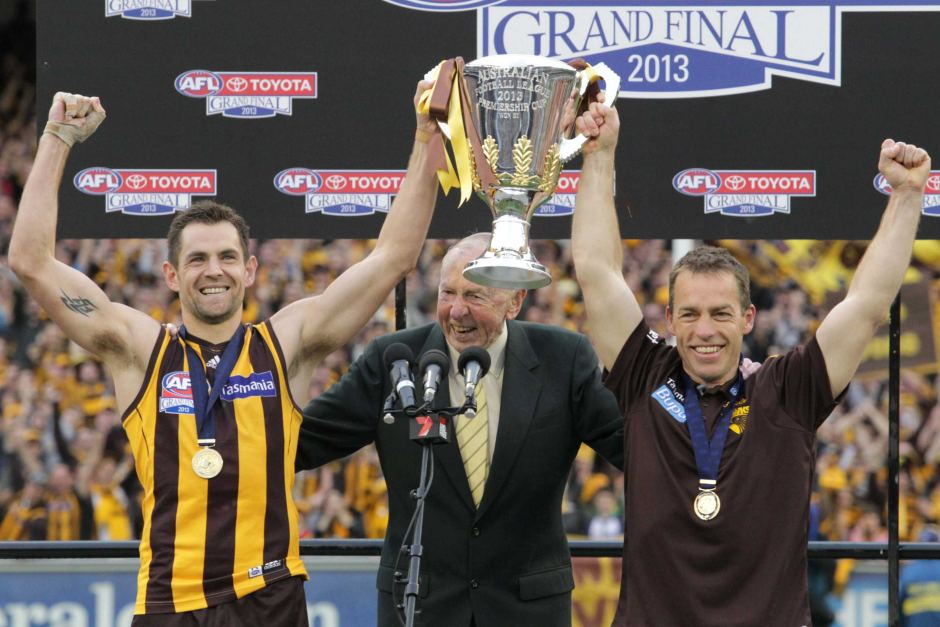
Luke Hodge and Alastair Clarkson after winning the 2013 Premiership
There are two other teams I wish to mention. These happen to be the two most recent, and overlapping, eras on the list - the arch rivals of modern times - Alastair Clarkson's Hawthorn of 2008-2015 and Geelong of 2007-2011 coached by Mark Thompson and Chris Scott.
Let's start with Geelong. If you look at the stats table, they top, or equal top, every single match stat - winning percentage of games for overall, home, and away - same goes with the all-important points percentage (points for/ points against).
Here is the table again. Behold Geelong's row of highlighted stats.
Click to enlarge

This stat-topping Geelong unit had a plethora of greats including Gary Ablett Jr, Joel Selwood, Jimmy Bartel, Steve Johnson plus many more. There is no doubt they regularly fielded some of the best line-ups in AFL history.
Mystery still surrounds the circumstances leading up to coach Mark Thompson's resignation at the completion of the 2010 season after finishing 3rd. Had his heart been in it that year? Would they have won it otherwise? Who knows, but Chris Scott was certainly lucky to inherit such an accomplished playing group whom he took to a premiership during his first year as coach in 2011. But alas, after 2011, there were no more grand final berths.
Although no other club matches Geelong's overall statistical dominance across five seasons, they are ranked 11th because this ranking system is weighted towards total premierships first and foremost. Geelong 'only' won three premierships and also didn't manage to go back-to-back. In fact, they are the only team to win three or more premierships in an era without winning any in succession.
Unfortunately for them, it all comes down to the 2008 grand final loss to Hawthorn. Mention this grand final to any avid Geelong supporter and the pain will be evident on their face. If they had won this grand final, their era would've yielded four premierships instead of three, and would've also most likely included a 'three-peat' instead of no consecutive premierships at all. Ouch. So did they blow it? I actually don't think so.
The Hawks had a freakishly talented side in 2008
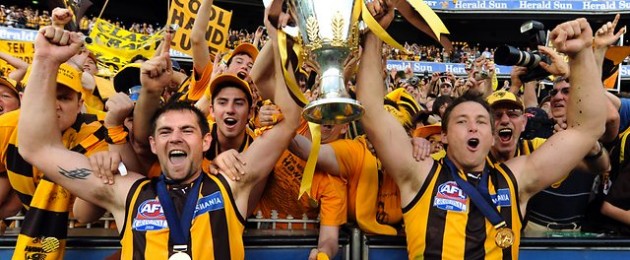
Luke Hodge and Stuart Dew celebrate with the 2008 Premiership cup.
After smashing Port Adelaide by a record margin in the 2007 grand final, Geelong were expected to go back-to-back in 2008. In the grand final, the bookies had installed them firm favourites against the younger Hawks who seemed to have come from nowhere in recent years to suddenly find themselves in the big dance. How could these young upstarts possibly bother the all-conquering Cats? One 'word': X-Factor.
X-factor is very hard to define. I'd say it has has something to do with performing almost-impossible feats when it matters most. This Hawks 2008 lineup had it in spades. They were younger, but not too much younger and still had plenty of seniority around with the likes of their spiritual leader and Brownlow medalist Shane Crawford, and the powerfully versatile key position player Trent Croad. Sadly, but maybe fittingly, for both of these club stalwarts the 2008 grand final would be their last game.
At the other end of the spectrum, the Hawks had the amazingly talented Cyril Rioli who was playing his first season and, speaking of X-factor, they had a mercurial medium-sized forward, with a penchant for imaginary shotguns, by the name of Mark Williams. He kicked a game-high three goals without even firing an imaginary shot! (His shotgun celebration had been banned earlier in the season by Alastair Clarkson).
Then you had Stuart Dew. An experienced recruit whose awe-inspiring third quarter purple patch was one for the ages. X-factor again.
When you also take into account that Coleman medalist Lance "Buddy" Franklin, Jarryd Roughhead, Luke Hodge, Sam Mitchell, Jordan Lewis, Grant Birchall, Campbell Brown, and Brad Sewell had just entered their prime, the level of talent starts to look frightening.
I feel that in the 2008 grand final, Geelong didn't blow it, they were simply beaten by a better side. A side whose same core group of players, although faltering to miss the finals in 2009, would ultimately go on to reach four more grand finals and win three more premierships - all in succession. That's why Alastair Clarkson's men are ranked so high (4th) on the all-time list of the great AFL eras.
So there you have it! I chose not to go into the details surrounding all 12 eras in the list, but I am satisfied with my ranking method. Any feedback is welcome - please leave a comment!
Cheers,
Paul P Mark




